Sealed Packages: Maximizing a Pool
10/18/2024
Sealed is the least understood Magic format by far. A big part of that is simply the general perception of it as a low agency, high variance format; and this is especially the case since we've entered the Play Booster era. I think at this point most players recognize that there's a lot of skill and agency involved in drafting and building a draft deck - but the same cannot be said of sealed.
I can guarantee that every single weekend with a big sealed tournament (whether it's Arena Opens or Arena Qualifiers or the upcoming Vegas 100k), I'll see many Magic players online lamenting how unlucky their pool was, or how lucky their opponents' pools were. And these sentiments are almost always extremely defeatist, even compared to most bad beats stories - players seem to see a large difference in card quality and assume that the gap is too wide to overcome, too absolute to even attempt to fight against.
Almost always, this boils down to the rares. I cannot tell you how many screenshots I've seen showing 4 or 5 leylines, rare lands, or other unplayable rares opened in an Arena Open, with a caption expressing frustration or defeat. I cannot tell you how many times I've heard a Magic player tell me "my deck could never beat theirs, they had so many rares!" when describing a match of sealed.
This isn't to say there isn't a grain of truth to all these bad beats - sealed is in fact one of the highest variance formats there is; and rares do often heavily contribute to the shape of a sealed pool; and there defintiely are sealed matches that are quite imbalanced in one direction or the other purely based on the pools each player opened.
But, as with everything, the main problem boils down to the lack of nuance.
So today, as we come up on the Arena Qualifier this weekend, and the Vegas 100k Sealed Open next weekend, let's talk about some of that sweet sweet nuance. Specifically: let's talk debunk that commonly held sentiment that rares are everything in sealed.
Part 1: Maximization
So, fundamentally, why exactly do we focus so much on rares?

because they're the best cards, duh
Okay, okay. This is kind of a silly question. But bear with me for a bit.
The way I see it, the main reason why so much emphasis is generally put on the rares of a sealed pool is simply that those are often also the best, most powerful cards in a sealed pool.
And this is a good first step! One of my fundamental beliefs about how to succeed in sealed is simply that you want to be maximizing your pool. Figure out what strengths are present within the 84 cards of your sealed pool, and figure out how to best play to those strengths!
But then, I'd also say that the main reason why rares specifically are focused on - often to the exclusion of all else - is, well, an unsurprising lack of nuance.
We can do better.
Level 1: The Best Individual Cards
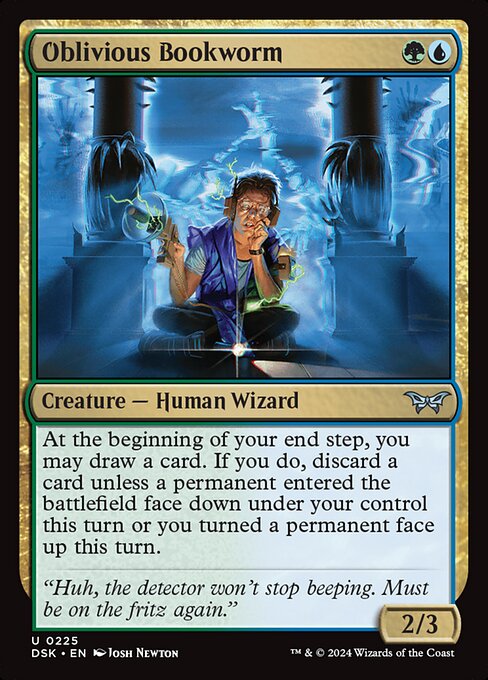
not a rare, but can feel like one
If level 0 is focusing on the rares, then level 1 is just going a bit further, to the next obvious step: broadening your considerations to all of the cards in your pool.
Of course, this isn't a huge leap by any stretch. It's impossible to build a sealed pool without at least glancing at commons and uncommons, after all. But the main point here is that you should specifically ignore the rarity symbol when asking what the best cards in your pool are.
Rares are often quite powerful, and almost always comprise the top cards in a set - but there are definitely pools where this isn't the case!
Think of those aforementioned screenshots with 4 leylines or rare lands. It's easy to look at that initial screen in an Arena Open and feel terrible. And certainly, the fact that you didn't open three copies of
Valgavoth's Onslaught makes your pool weaker than one that did. But just because you have dud rares, doesn't mean there's no power in your pool whatsoever.Every set has plenty of very powerful uncommons. Having multiple copies of
Oblivious Bookworm or Gremlin Tamer might even be more desirable that one copy of a good rare! And in some sets (though not really in DSK), there are even uncommons that can be better than almost every rare in the set.So, level 1 is all about not over-indexing on your rares. Sure, the best sealed pools will have multiple very good rares; but you can quite easily build a good sealed pool without any rares at all.
Level 2: The Best Packages

synergy is key
If level 0 is primarily looking at rares, and level 1 is looking at every single card; then level 2 is taking the nuance one step further, and considering every card in the context of your pool.
It turns out that, perhaps a bit unintuitively, context matters even more in sealed than it does in draft for the purpose of evaluating cards. This is because you just have less control over your sealed pool than over what cards you draft.
In draft, if you're deciding whether or not to take a card that depends on heavy synergies, you can to some extent evaluate that card under a framework that assumes that you will direct your draft in a way that best takes advantage of it. Of course, as you get deeper and deeper into the draft, you end up with less and less flexibility, and thus have to gradually start evaluating cards more in the context of your deck. But still fundamentally, you have more freedom in draft to evaluate cards closer to their ideal cases.
Sealed is much tougher on this axis. Every time you open a new sealed pool, you should throw out all preconceptions you have for how easy or hard it is in general to support any buildarounds you open, and instead focus on the very concrete question of how well supported each card factually is.
Failing to do this is one of the most common mistakes I see players make in sealed. Take the card
Ethereal Armor, for instance. This is generally quite a powerful card, and can definitely be a high pick in draft! But if you open your sealed pool and are looking at a deck that, for one reason or another, only has 2 or 3 other enchantments you want to play... Well, a 1 mana +1/+1 first strike aura is pretty mediocre, so maybe you should reconsider exactly how much of a draw to white that Ethereal Armor actually is.And the trickiest part is, this is by no means limited to just traditional senses of "synergies" and "buildarounds"! The beauty of sealed is that there is just so much more variety than there is in draft, as you have so much less control over what cards you have - and this leads to a lot of evaluating cards in contexts you've never considered! As they say, restrictions breed creativity.
As such, the way I tend to look at sealed is through the lens of packages. What packages of cards do you have in your pool that work well together? How can you maximize supporting those packages? And finally, how can you put the best packages together to make a coherent deck?
Part 2: Examples
As is often the case, I think the best way to demonstrate what I mean is by dissecting an example pool!
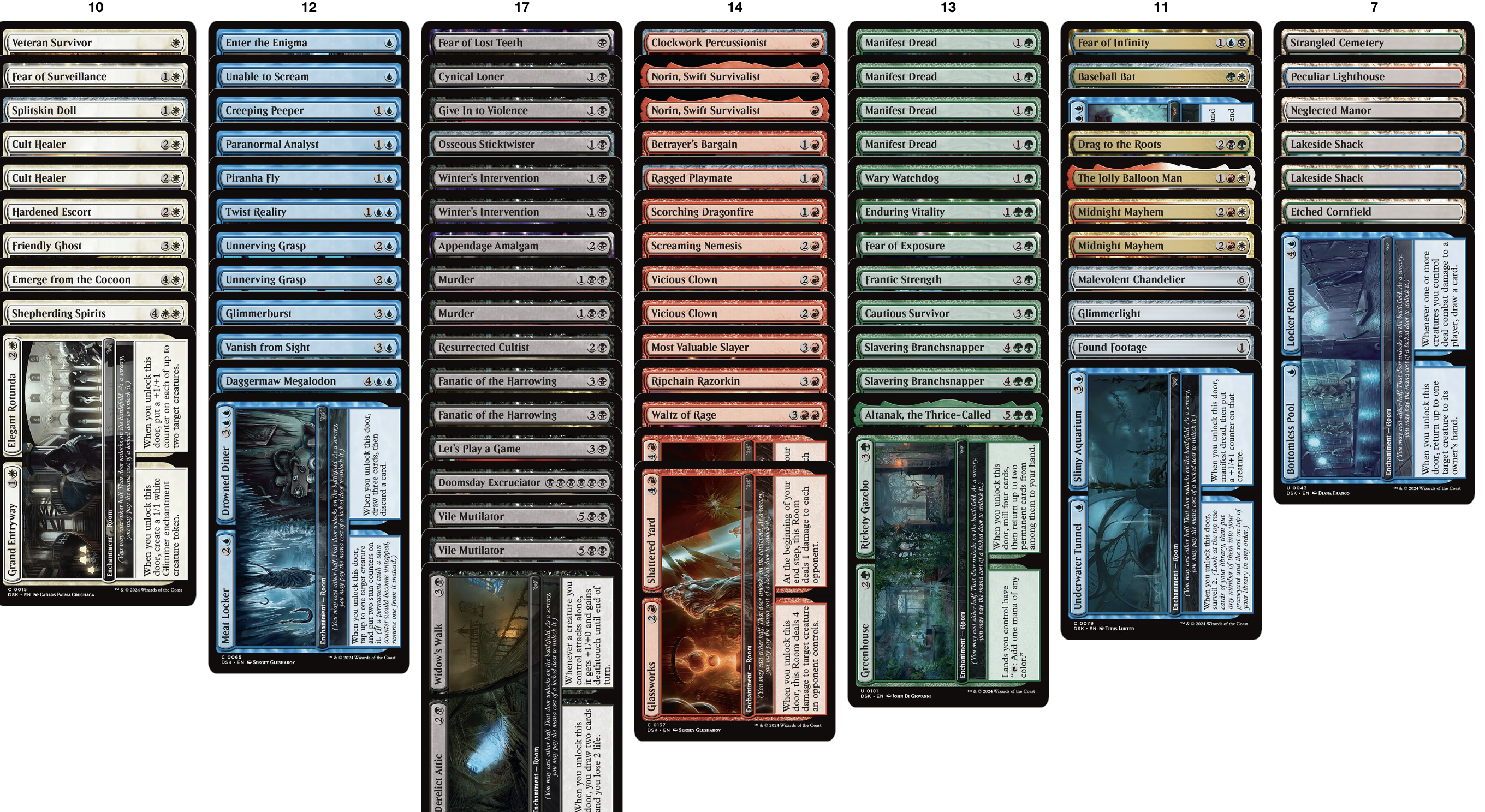
https://sealeddeck.tech/ycNJXuqhrw
Here's the pool we'll be looking at for all of these examples. Maybe try building it yourself before reading further!
Deep Red
One of the first things that jumped out to me about this pool was just how deep the red cards are!
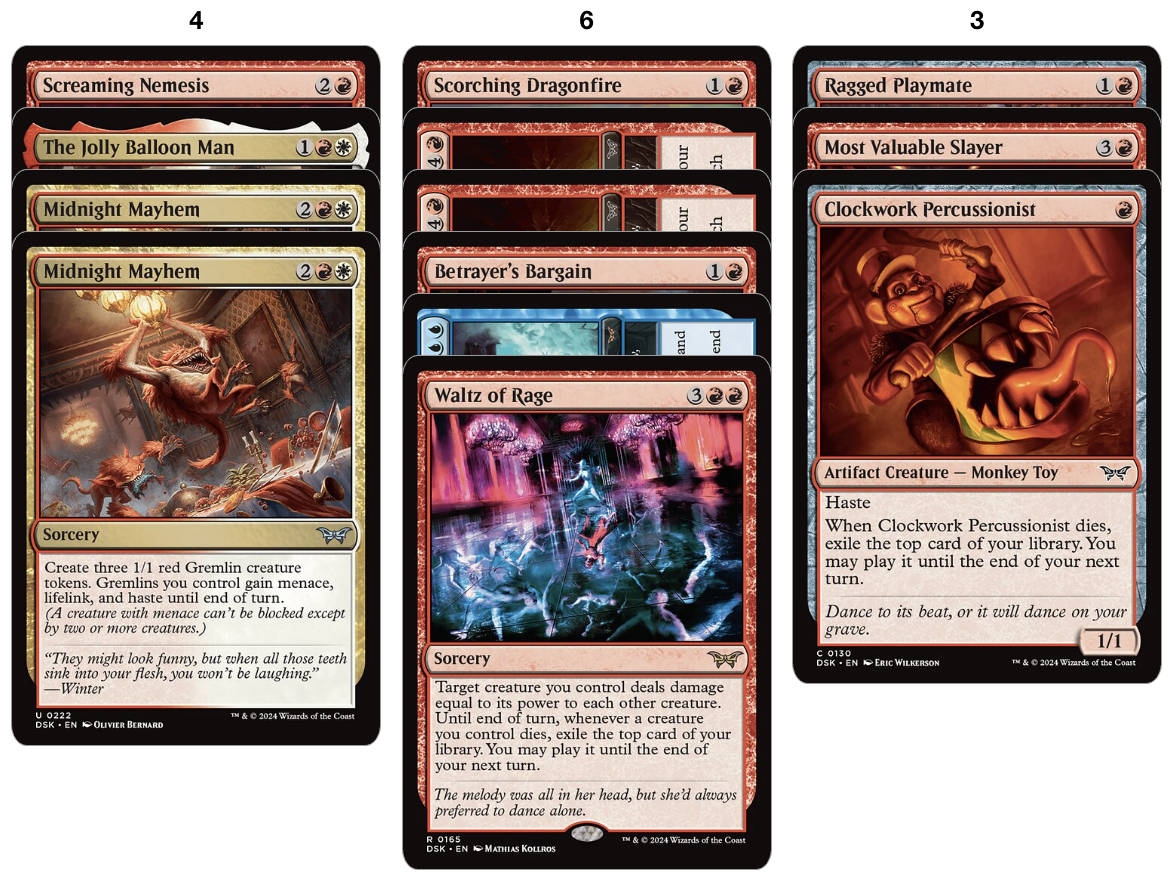
left is individually strong cards, middle is removal, right is strong aggressive cards
Five premium removal spells and a wrath, as well as many generally strong cards besides. In fact almost all of the best individual cards in the pool touch red - the only exceptions are
Enduring Vitality and Unnerving Grasp.Unnerving Blue
But speaking of Unnerving Grasp, having two copies of that card makes me quite interested in blue. What would come in that package?
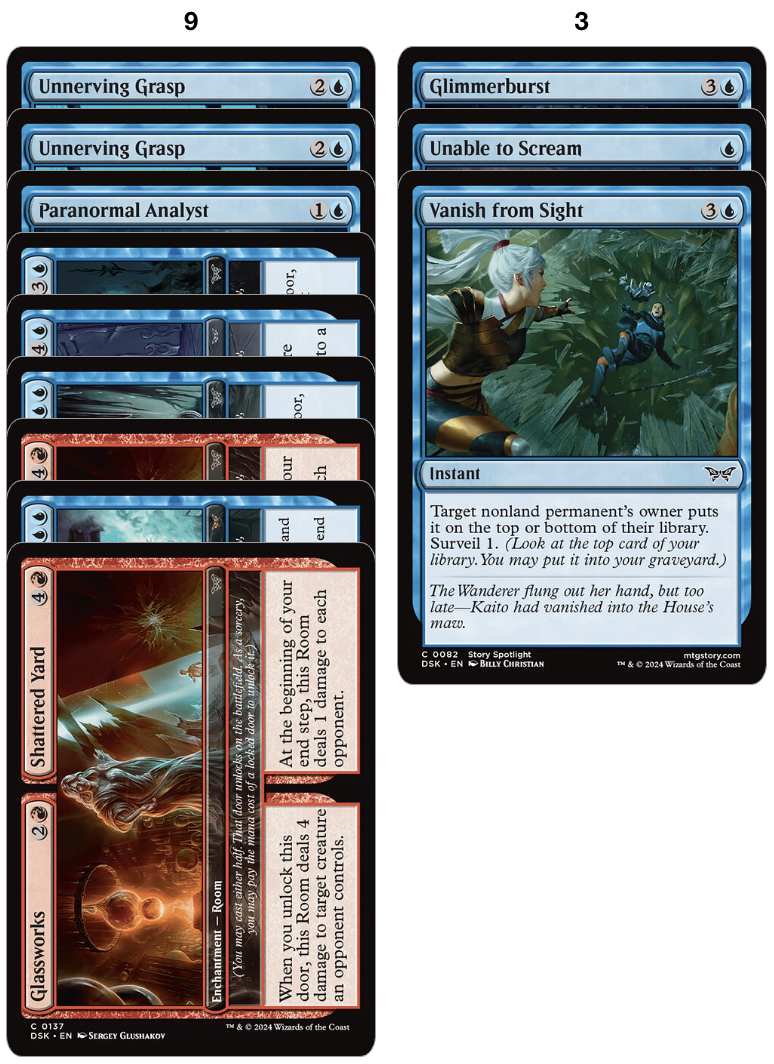
left is cards that synergize with Unnerving Grasp, right is generically good blue cards
Well, it's quite nice that all of our rooms work quite well with Grasp being able to reset them. And on top of that, we even have a
Paranormal Analyst, which also hooks back into synergizing with our Underwater Tunnel!So now a plan is starting to form. We can fit the majority of our good cards into a UR deck, so that direction looks appealing. But before we fully commit, let's explore some other directions and points of power to make sure we haven't missed anything.
"Splinter Twin"
Looking over at black, the cards that stand out the most to me are two copies of Vile Mutilator. That card can be extremely backbreaking, especially if it's cast multiple times or reanimated - but unfortunately, we don't have very many ways of doing either of those.
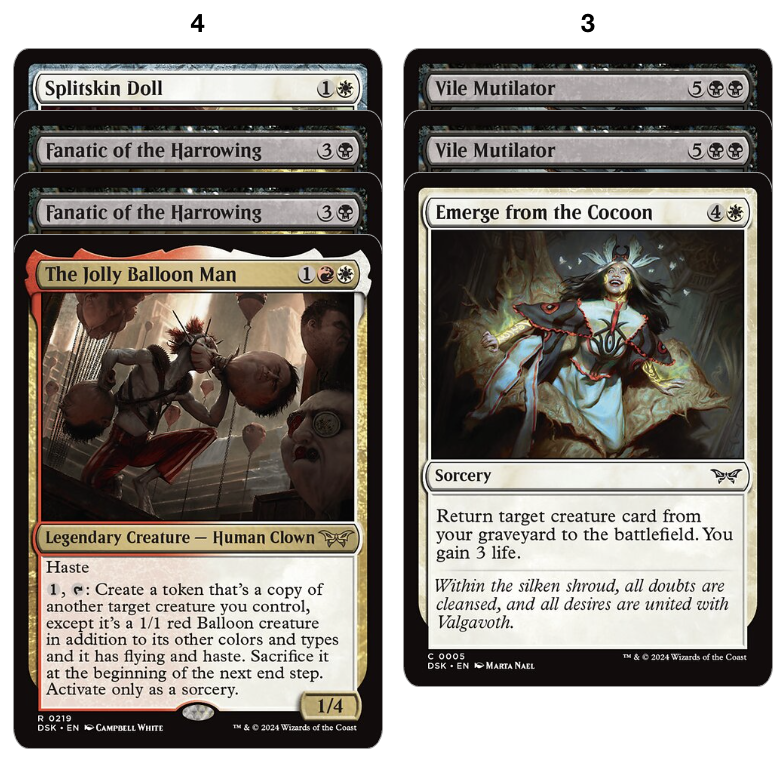
it's really funny that The Jolly Balloon Man works well with all of the discard enablers - if we had enough support for reanimator I suspect we'd also splash the Balloon Man, but alas
Synergistic Mayhem
Finally, one individually powerful card we have yet to talk about is
Midnight Mayhem.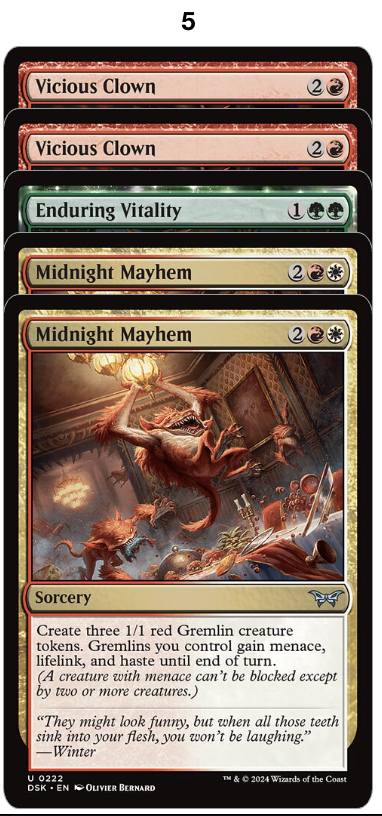
one of these is not like the other; one of these does not belong
Of course, this card is quite nice in just any aggressive deck, but it especially synergizes with our two copies of
Vicious Clown, especially if we can push the Clowns through.And perhaps a bit more spicy -
Enduring Vitality is actually also quite good with Mayhem, simply because the tokens proceed to tap for quite a bit of mana! Unfortunately though, there just isn't all that much else appealing in green as a color - so it's pretty hard to justify playing a 1GG card.Putting it Together
Okay, so we have two real potential directions: UR, leveraging our strong red cards along with our two Unnerving Grasps; or RW, leveraging our strong red cards along with our two Midnight Mayhems.
First up: let's look at RW:
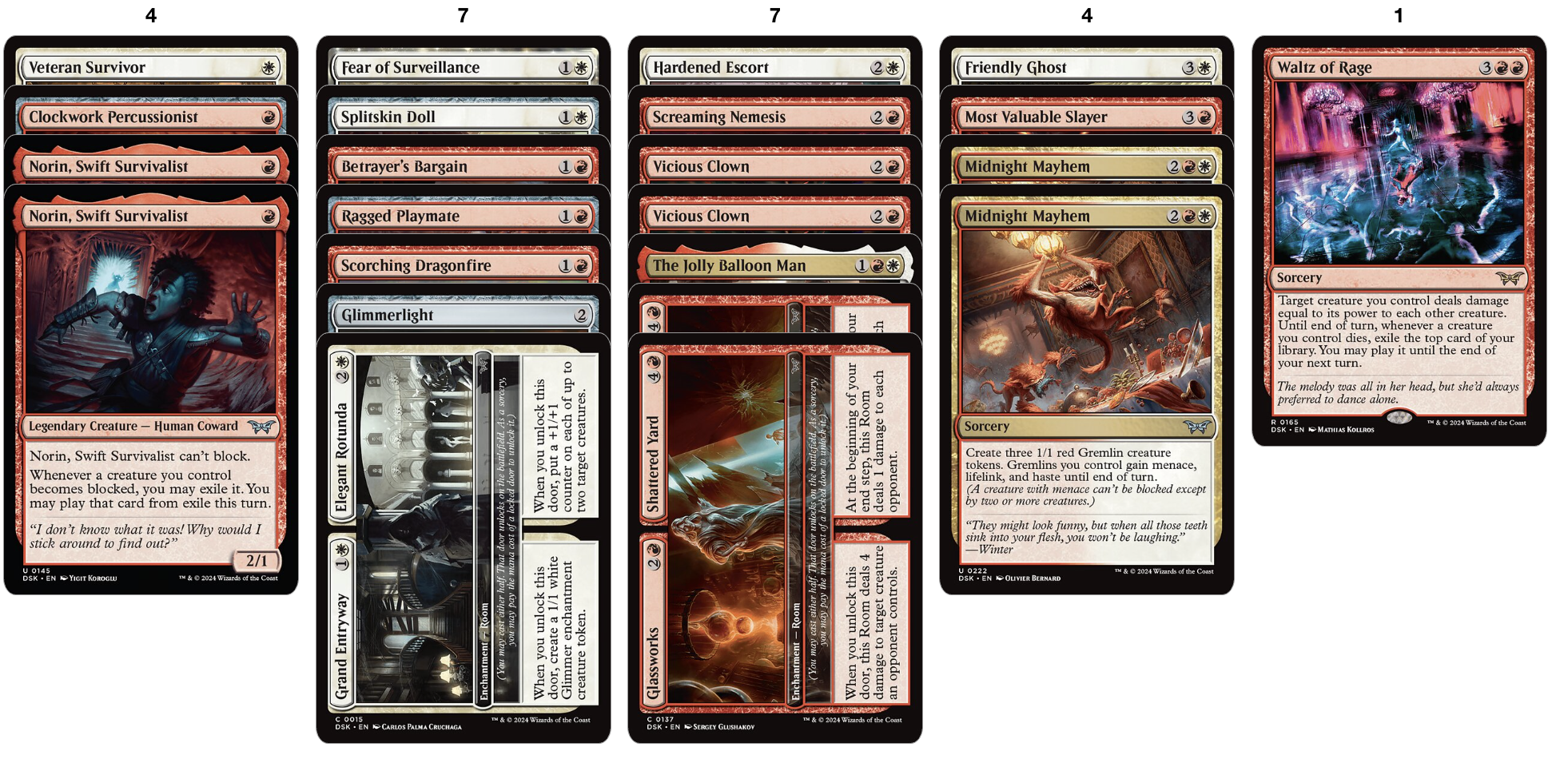
https://sealeddeck.tech/eNEVNW6unb
This deck kind of just builds itself, as you end up needing to play almost all of your red and white cards. It certainly looks okay, with some cards that are quite strong, and various cross-synergies. But I do worry that it might have some trouble pushing through blockers - especially with a card like Vicious Clown.
So let's look at UR next:
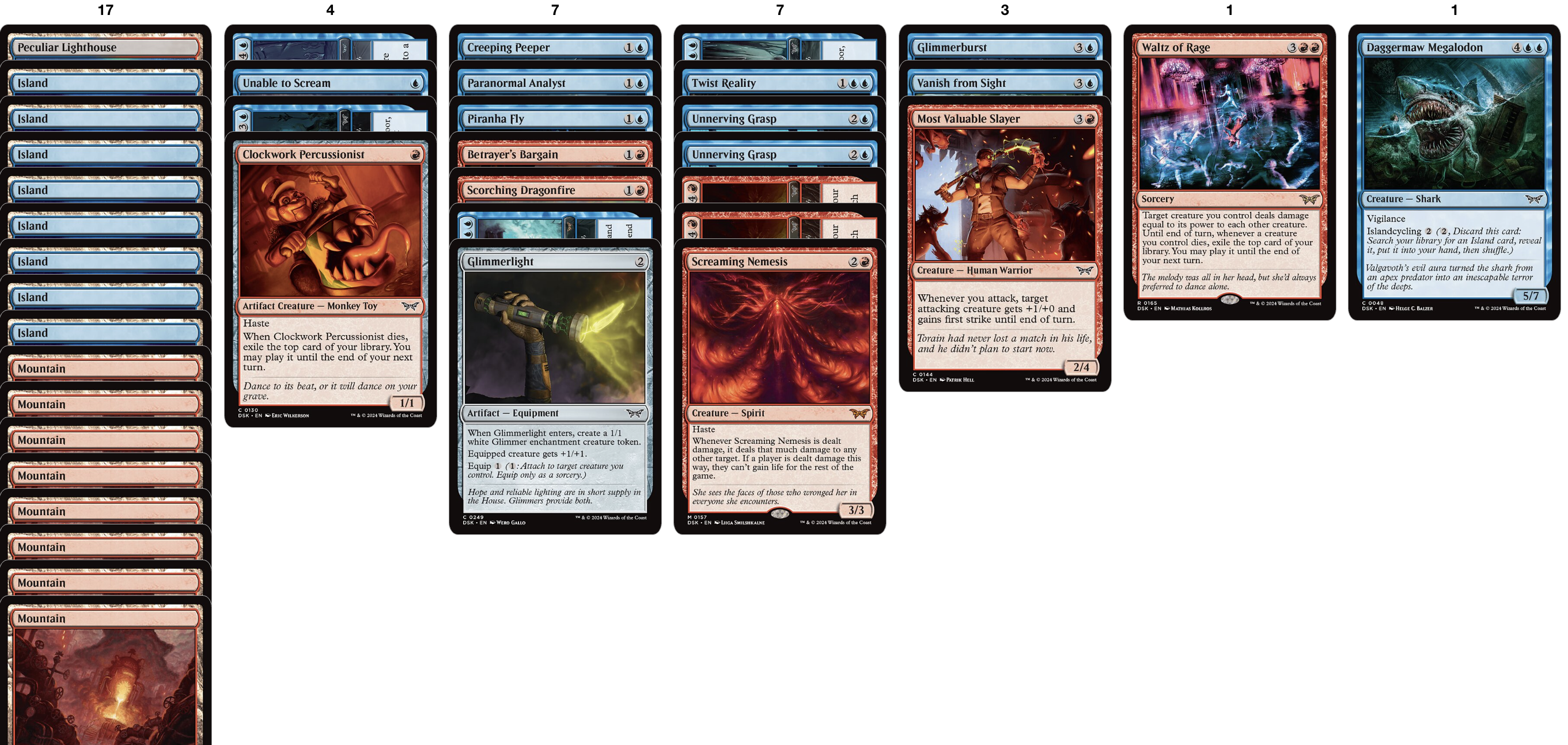
https://sealeddeck.tech/1IvubEYUNk
This one is a bit more open-ended, with more choices after the obviously good cards. I could definitely see a slightly different build with different choices for cards 21-23 being better.
But the core of the deck stays quite strong: all those great red cards, paired with some decent blue cards and two copies of Unnerving Grasp.
Ultimately, my instinct here would be to start by playing UR. But I could also certainly see myself sideboarding into RW if I felt I needed to be more aggressive in a matchup!
Conclusion
Fundamentally, this framework of looking at "packages" is pretty loosely defined. When I say "package", I can mean anything from simply a few individually strong cards of the same color drawing you to that color specifically, to a deep vein of 10 cards that form a cohesive unit of synergy with enablers and payoffs, to anything in-between.
But the main point is to pose an in-between step between looking at individual cards and looking at building an entire deck. After all, most synergies or interactions between cards occur on a smaller scale than the full 23 cards, so it makes sense to examine them primarily through that lens.
Really, the most important part of this methodology to me is that it strongly encourages you to fully explore your sealed pool, and do so in a nuanced way.
#FreePalestine | Consider donating to UNWRA or PCRF, supporting protesters locally, and educating yourself.
